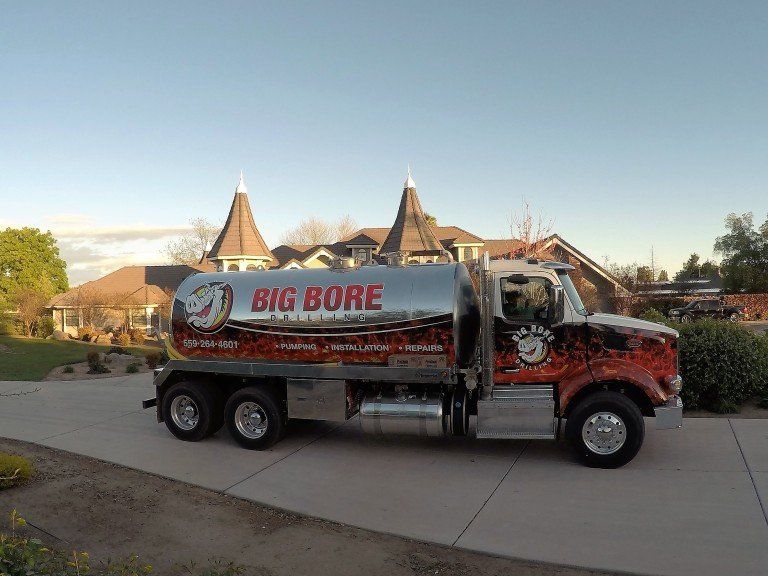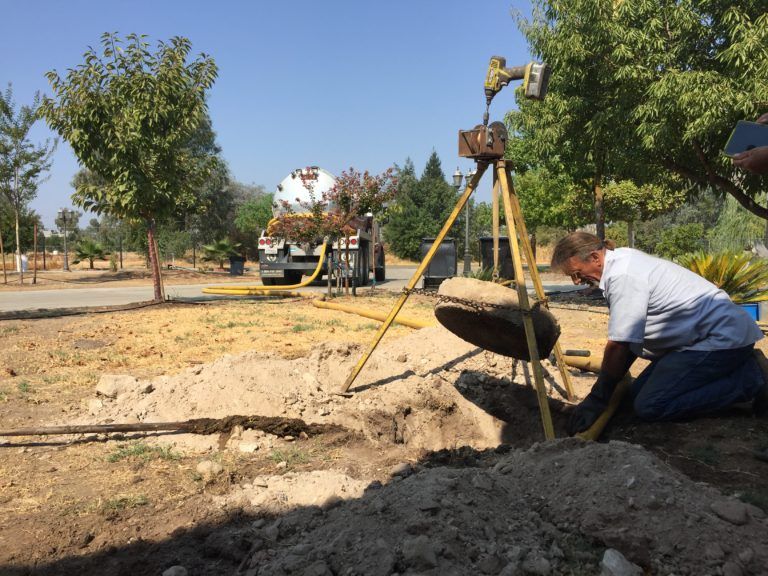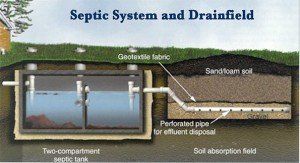Call Us Now! (559) 264-4601
Septic Tank Pumping & Maintenance IN FRESNO, CA
ALSO SERVING: Clovis, Madera, Sanger, Reedley, Selma, Kerman, Shaver Lake, Huntington Lake, and Surrounding Areas
Is your septic tank backing up? Call us and get it pumped today! Our friendly pump truck operators are septic experts who can get your tank pumped and your life back to normal quickly. Regular septic tank pumping is a key aspect of septic system maintenance.
hOW mUCH DOES septic tank pumping COST?
OPEN (Septic tank is dug up or exposed and we do not need to dig)................$450
CLOSED (Includes up to 1 hour of locating and digging up septic tank)............$650
All properties with addresses between 25000<----->30000 .........................add $250
All Properties with addresses greater than 30000.......................................add $450
Why is My Septic Tank Backing Up?
Getting your septic tank pumped is the best way to asses the health of your septic system. When we open the tank and pump it we get a better understanding of whats going on in your system. Are there roots in the tank? Is the hang down clogged? Does water flow freely from the house to the tank? Was the tank overfull? Is the leach line overfull? These are questions we find answers to when we pump the septic tank.
Septic tanks can get backed up for a few different reasons. Pumping your tank every 3-5 years is the best practice to keep your septic system healthy. When the time between pumping exceeds this range, the amount of solids built up in the tank can cause some problems. When the tank becomes too full of solids, they can make their way out of the tank and into the leach line or drain wells. Solids in the drainage system contribute to the growth of a bio mat in the soil which greatly reduces the ability of the leach line or drain well to percolate water back into the ground. If your septic tank is backing up repeatedly over a short period of time the issue could be that your drainage system is in failure and additional drainage will need to be added.
Roots are also a very common reason why septic systems start backing up. Tree roots seek out septic tanks and leach lines because of the moisture. Trees planted too close to a septic system can cause major problems. Roots can clog pipes or completely fill entire septic tanks over the years.
Tank Sizes
The most common septic tank size is 1500 gallons. Some small 1-2 bedroom homes or cabins may have a smaller tank such as a 1000 gal or 750 but this is less common. Large homes with more than 5 bedrooms could have a 2000 gallon tank.
Digging Up the Septic Tank
We will be happy to dig up the septic tank for you to save you the time and back ache of shoveling. Septic tank lids are usually 2-4 feet below the surface. Some septic tanks have risers in which case little to no digging is required. The first compartment of the septic tank is where it needs to be dug up. Lids sizes can very. Common sizes and shapes are: 24″ diameter circle, 24″ X 24″ square, Wing lid crescent moon shape various sizes.
Locating the Septic Tank
Property owners should keep a drawing of the septic system which would show the location of the septic tank. If you don’t have a drawing, contact your county office to see if one is available. If no drawing exists location is more difficult. We have special tools like probes and tracers that can help us determine your tanks location. Coupled with our extensive septic system knowledge, we are able to locate most septic tanks.
Septic Tank pumping is our specialty, Call us today for a free quote!
Septic Tank Pumping FAQs for Homeowners in Fresno & Madera Counties
How do I know if my septic tank needs pumping?
Warning signs include slow drains, gurgling pipes, wet spots in your yard, or sewage odors near the tank.
How frequently does a septic tank need to be pumped?
We strongly recommend regular pumping every 3-5 years for an average size residential household with normal water use. It may be advisable to pump more frequently if you use more water, have more than 6 people in the residence, have a tank smaller than 1500 gallons, or pre-existing concerns/issues with your leach field /drainage system.
I just had my septic tank pumped recently—why is it full again? What can cause a tank to need more frequent pumping?
If your tank seems full shortly after being pumped, a few common issues might be at play. The most frequent cause is excess water entering the system — often from a leaky toilet or constantly running fixtures. Even a slow leak can send hundreds of gallons of clean water into the tank each day, filling it much faster than normal.
In other cases, the problem isn’t with the tank at all, but with the leach field or drain system. If the leach lines are clogged, oversaturated, or in failure, wastewater can’t properly drain, causing the tank to back up.
We recommend checking your fixtures for leaks, minimizing water use during wet weather, and calling us for a system assessment if the problem persists. Early detection can help avoid costly septic repairs.
Can Big Bore inspect the leach field too?
During septic tank pumping, signs of leach field issues — such as standing water in the tank or slow drainage — may become apparent. While standard pumping doesn’t include a full leach field inspection, we do offer leach field evaluations and repairs if needed. If our technicians notice anything unusual, we’ll let you know and can discuss next steps.
Does Big Bore schedule routine septic pumping?
We can only arrange for routine pumping if your tank needs recurring service more frequently than once a year.
How much does septic tank pumping/cleaning cost?
Our pumping services vary depending on location, tank size, and depth. Please see the general pricing details above or contact us for a free estimate over the phone.
Do I need to dig for tank access before technicians arrive?
No, our team can hand-excavate for an additional charge. We would only ask someone be on site to provide assistance in locating the tank. However, if you'd like to provide access to the tank by digging yourself, you can avoid all dig fees.
What sort of access to my property do I need to provide for the pump truck?
Our pump truck has 100 feet of hose that can be used to reach from its location to your septic tank. Depending on where your tank is situated on your property, we may need to park the truck further up the driveway or off-pavement in order to reach the tank. This is especially important when the ground around your property is wet from rain or particularly muddy.
Does someone need to be there during the appointment?
No, it is not usually required that someone be on site during the entire appointment for standard routine pumping. If payment is best handled with credit card over the phone, we are happy to accommodate your scheduling needs and can plan accordingly.
Will the pumping technicians need access to inside of the home or buildings on the property during the visit?
Our technicians can usually do the entire visit without entering the inside of any buildings. If locating the tank proves to be difficult, however, we might request quick access to flush a sensor to direct them to the tank's location.
What types of payment do you accept?
For pumping, we prefer either cash or personal check, and can also accept credit cards.
Where are the lids to my septic tank located? How can I find them?
The lids to your septic tank are typically located about 1.5ft - 3ft underground if there are no risers. Most residential tanks have at least 2 lids, one for each compartment of the tank. Our team is trained and very capable of finding the lids location and digging them up for a reasonable fee.
What are risers?
Risers are an extension to the lid of the septic tank that brings the opening up to grade, eliminating the need to dig down to the tank itself to access for pumping and other maintenance. Most septic pumpers charge dig fees, so risers offer both a financial and a practical investment in your system for the rest of its lifespan.
My tank seems to have two lids/two compartments. What is going on there?
Septic tanks have multiple compartments, with access to each, to separate solid waste from liquid wastewater. The different compartments are frequently called the "solid-side" and the "water-side".
What are the pipes sticking up around my house?
If the pipe is 4" diameter PVC, it is likely a sewer line clean-out. This pipe is an access point for plumbing/snaking the line, as well as allowing for sewer gases to escape outside your house rather than back through your home's plumbing. If the pipe is significantly larger, roughly 18"-24" in diameter, then it is probably a riser for accessing your tank.
How big is the Big Bore Drilling pump truck? How much can you pump at once?
Our pump truck has a 3600 gallon maximum capacity.
I have a special case or engineered system I'm not sure how to properly care for; can Big Bore help with systems they didn't install themselves?
Yes, we would be more than happy to provide our expertise in anything septic related!
Where does the pumped waste go? Where does the pump truck dump?
Per local county laws, Fresno and Madera County wastewater treatment facilities can only accept sewage that was pumped in the same county.



